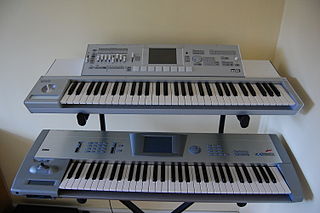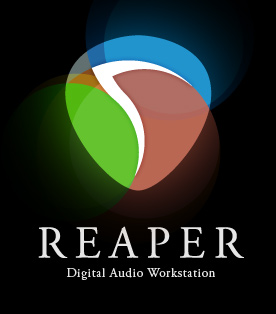
MIDI is a technical standard that describes a communication protocol, digital interface, and electrical connectors that connect a wide variety of electronic musical instruments, computers, and related audio devices for playing, editing, and recording music.

FL Studio is a digital audio workstation (DAW) developed by the Belgian company Image-Line. It features a graphical user interface with a pattern-based music sequencer. It is available in four different editions for Microsoft Windows and macOS.
Steinberg Media Technologies GmbH is a German musical software and hardware company based in Hamburg. It develops software for writing, recording, arranging and editing music, most notably Cubase, Nuendo, and Dorico. It also designs audio and MIDI hardware interfaces, controllers, and iOS/Android music apps including Cubasis. Steinberg created several industry standard music technologies including the Virtual Studio Technology (VST) format for plug-ins and the ASIO protocol. Steinberg has been a wholly owned subsidiary of Yamaha since 2005.

Virtual Studio Technology (VST) is an audio plug-in software interface that integrates software synthesizers and effects units into digital audio workstations. VST and similar technologies use digital signal processing to simulate traditional recording studio hardware in software. Thousands of plugins exist, both commercial and freeware, and many audio applications support VST under license from its creator, Steinberg.
Emagic was a music software and hardware company based in Rellingen, Germany and a satellite office in Grass Valley, California. On July 1, 2002 Emagic was bought by Apple Computer. Emagic's Windows-based product offerings were discontinued on September 30, 2002.

The Korg Triton is a music workstation synthesizer, featuring digital sampling and sequencing, released in 1999. It uses Korg's "HI Synthesis" system and was eventually available in several model variants with numerous upgrade options. The Triton became renowned as a benchmark of keyboard technology, and has been widely featured in music videos and live concerts. At the NAMM Show in 2007, Korg announced the Korg M3 as its successor.
TASCAM is the professional audio division of TEAC Corporation, headquartered in Santa Fe Springs, California. TASCAM established the Home Recording phenomenon by creating the "Project Studio" and is credited as the inventor of the Portastudio, the first cassette-based multi-track home studio recorders. TASCAM also introduced the first low-cost mass-produced multitrack recorders with Simul-Sync designed for recording musicians, and manufactured reel-to-reel tape machines and audio mixers for home recordists from the early 1970s through the mid-1990s. Since the early 00's, TASCAM has been an early innovator in the field-recording and audio accompaniment to video with their DR-series recording platforms. TASCAM celebrated its 50th anniversary in 2021.
M-Audio is a business unit of inMusic Brands that designs and markets audio and MIDI interfaces, keyboards and MIDI controllers, synthesizers, loudspeakers, studio monitors, digital DJ systems, microphones, and music software. The company has independent offices in the US, Canada, UK, Germany, France and Japan.

REAPER is a digital audio workstation and MIDI sequencer application created by Cockos. The current version is available for Microsoft Windows, macOS, and Linux. REAPER acts as a host to most industry-standard plug-in formats and can import all commonly used media formats, including video. REAPER and its included plug-ins are available in 32-bit and 64-bit format.
Sonar was a digital audio workstation created by the former Boston, Massachusetts–based music production software company Cakewalk. It was acquired by Singaporean music company BandLab Technologies and renamed Cakewalk by BandLab.
Human User Interface Protocol is a proprietary MIDI communications protocol for interfacing between a hardware audio control surface and digital audio workstation (DAW) software. It was first created by Mackie and Digidesign in 1997 for use with Pro Tools, and is now part of the Mackie Control Universal (MCU) protocol.

The KRISTAL Audio Engine is a digital audio workstation for Microsoft Windows. It is free for personal & educational use, with licensing options for commercial use.

Progression, previously stylized as PROGRESSION, was a music creation and performance computer program created by NOTION Music. Created for use on Microsoft Windows and macOS laptops or desktops, Progression focused on composition for guitar, but could also be used to compose for keyboards, bass, and drums. As of April 2019, Progression is no longer available for sale in the PreSonus online store, nor via dealers worldwide.

Notion, previously stylized as NOTION, is a computer software program for music composition and performance, created by NOTION Music of Greensboro, North Carolina. NOTION Music was acquired by PreSonus in 2013 which in turn was acquired by Fender Musical Instruments in 2021. Notion 6 is available on Microsoft Windows and macOS, and Notion Mobile is available for Windows, macOS, iOS, Android and Fire OS.

RADAR is a product line of professional digital multitrack recorders capable of recording and playing back twenty-four tracks of audio.

MAGIX Samplitude/ Sequoia is a computer program made by MAGIX for recording, editing, mixing, mastering and outputting audio. The first version was released in 1992 for the Amiga and three years later for Microsoft Windows. The latest versions of the software are Samplitude Pro X5, Samplitude Pro X5 Suite and Sequoia 16. Samplitude is an example of a digital audio workstation (DAW).

Audio Random Access is an extension for audio plug-in interfaces, such as AU, VST and RTAS, allowing them to exchange a greater amount of audio information with digital audio workstation (DAW) software. It was developed in a collaboration between Celemony Software and PreSonus.

Studio One is a digital audio workstation (DAW) application, used to create, record, mix and master music and other audio, with functionality also available for video. Initially developed as a successor to the KRISTAL Audio Engine, it was acquired by PreSonus and first released in 2009 for macOS and Microsoft Windows. PreSonus and Studio One were then acquired by Fender in 2021.

An audio interface is a piece of computer hardware that allows the input and output of audio signals to and from a host computer or recording device.

A bedroom producer is an amateur musician who creates, performs, and records their music independently using a home studio, often considered a hobbyist opposed to a professional record producer in the recording industry that works in a traditional studio with clients. Typically bedroom producers use accessible digital technology that costs less than the equipment in a professional studio, such as MIDI controller-based instruments and virtual studio technology, to create music for release to the world. While a professional record producer oversees and guides the recording process, often working alongside multiple people such as studio musicians, singers, engineers, mixers, songwriters, arrangers, and orchestrators, a bedroom producer does everything independently: creating the ideas, recording them and processing them for release. Bedroom producers are often self-taught, learning sound design, mixing and music theory by reading music production blogs and watching tutorials on the internet. As bedroom producers depend on the accessibility of music technology, bedroom production has been made easier with advances in home computing power and digital audio workstations (DAW).















